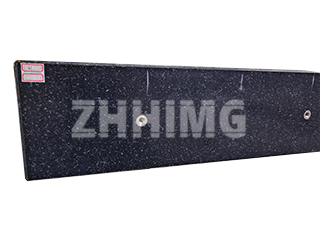In the rigorous world of ultra-precision manufacturing, where errors are measured in microns and nanometers—the very domain where ZHHUI Group (ZHHIMG®) operates—the integrity of every component is paramount. Often overlooked, but undeniably critical, are thread gauges. These specialized precision instruments are the final arbiters of dimensional accuracy, ensuring that the threaded fasteners and components holding our most sophisticated technologies together are fit for purpose. They are the essential link between design specifications and functional reality, particularly in high-stakes sectors like aerospace, automotive, and advanced industrial machinery.
The Foundation of Fastener Reliability
Simply put, a thread gauge is a quality control tool used to verify that the screw, bolt, or threaded hole conforms to exacting specifications, guaranteeing a proper fit and preventing catastrophic failure. Without them, even the slightest deviation in thread pitch or diameter could compromise product function, create safety hazards, and introduce operational inefficiencies that halt production lines.
The importance of these gauges lies in their ability to ensure compliance with global engineering mandates, specifically the rigorous ISO and ASME standards. For professional quality assurance and manufacturing teams, integrating thread gauging results with advanced digital tools—such as digital micrometers or specialized data acquisition software—streamlines the reporting process, providing standardized, quantifiable feedback across all departments.
Demystifying the Thread Gauge Arsenal: Plug, Ring, and Taper
Understanding the core types of thread gauges is fundamental to achieving optimal use in machining, manufacturing, and metrology applications:
Plug Gauges (For Internal Threads)
When inspecting an internal thread—think a tapped hole or a nut—the thread plug gauge is the tool of choice. This cylindrical, threaded tool is characterized by its dual-sided design: the “Go” side and the “No-Go” (or “Not Go”) side. The “Go” gauge confirms that the thread meets the minimum size requirement and can be fully engaged; the “No-Go” gauge validates that the thread has not exceeded its maximum tolerance. If the “Go” end spins smoothly, and the “No-Go” end locks immediately upon entry, the thread is compliant.
Ring Gauges (For External Threads)
For measuring external threads, such as those on bolts, screws, or studs, the thread ring gauge is employed. Much like the plug gauge, it features “Go” and “No-Go” counterparts. The “Go” ring should effortlessly slide over a correctly sized thread, while the “No-Go” ring ensures the thread diameter is within the acceptable range—a crucial test of dimensional integrity.
Taper Gauges (For Specialized Applications)
A specialized instrument, the tapered thread gauge, is indispensable for evaluating the accuracy of tapered connections, typically found in pipe fittings or hydraulic components. Its gradually narrowing profile matches the diameter change of the tapered thread, ensuring both proper alignment and the tight seal necessary for pressure-sensitive applications.
Anatomy of Precision: What Makes a Gauge Reliable?
A thread gauge, much like a gauge block—another critical piece of dimensional inspection equipment—is a testament to engineering precision. Its accuracy is built upon several key components:
- The Go/No-Go Element: This is the core of the verification process, confirming dimensional requirements dictated by manufacturing standards.
- The Handle/Housing: High-quality gauges feature an ergonomic handle or durable casing for ease of use, enhancing stability during critical thread inspection and prolonging the tool’s lifespan.
- Material and Coating: To resist wear and corrosion, thread gauges are crafted from wear-resistant materials like hardened tool steel or carbide, often finished with coatings such as hard chrome or black oxide for stability and longevity.
- Thread Profile and Pitch: The heart of the gauge, these factors are precisely cut to define compatibility with the workpiece.
- Identification Markings: Premium gauges carry permanent, clear markings detailing thread size, pitch, fit class, and unique identification numbers for traceability.
Maintenance and Best Practices: Extending Gauge Lifespan
Given their role as precision reference standards, thread gauges demand careful handling and consistent maintenance. Improper use or storage is the leading cause of inspection errors.
| Best Practices for Longevity | Pitfalls to Avoid |
| Cleanliness is King: Wipe gauges before and after every use with a soft, lint-free cloth and a specialized cleaning solvent to remove debris or oil that affects accuracy. | Forceful Engagement: Never try to force a gauge onto a thread. Excessive force damages both the gauge and the component being inspected. |
| Proper Lubrication: Apply a minimal amount of anti-rust oil, especially in humid environments, to prevent corrosion, which is the primary killer of gauge accuracy. | Improper Storage: Do not leave gauges exposed to dust, moisture, or rapid temperature swings. Store them securely in dedicated, temperature-controlled cases. |
| Regular Visual Checks: Routinely inspect the threads for signs of wear, burrs, or deformation before use. A damaged gauge yields unreliable results. | Ignoring Calibration: Uncalibrated gauges provide unreliable readings. Utilize certified calibration equipment, such as master gauge blocks, and adhere strictly to a regular calibration schedule. |
Troubleshooting Mismatches: When a Thread Fails the Test
When a gauge fails to mate as expected—a “Go” gauge doesn’t enter, or a “No-Go” gauge does—a systematic troubleshooting approach is essential to maintain measurement integrity:
- Inspect the Workpiece: The most common culprit is contamination. Visually check the thread for dirt, chips, cutting fluid residue, or burrs. Clean the part thoroughly using appropriate methods.
- Inspect the Gauge: Check the gauge for any signs of wear, nicks, or damage. A worn gauge may inaccurately reject a good part, while a damaged one will certainly provide a false reading.
- Confirm Selection: Double-check the documentation to ensure the correct gauge type, size, pitch, and class (e.g., Class 2A/2B or high-tolerance Class 3A/3B) is being used for the application.
- Recalibrate/Replace: If the gauge itself is suspected of being out of tolerance due to wear, it must be verified against certified standards. A heavily worn gauge must be replaced to ensure reliable performance.
By mastering the types, structure, and maintenance of these critical tools, professionals ensure that every thread—from the smallest electronic fastener to the largest structural bolt—meets the unwavering standards required by the ultra-precision industry.
Post time: Nov-05-2025

